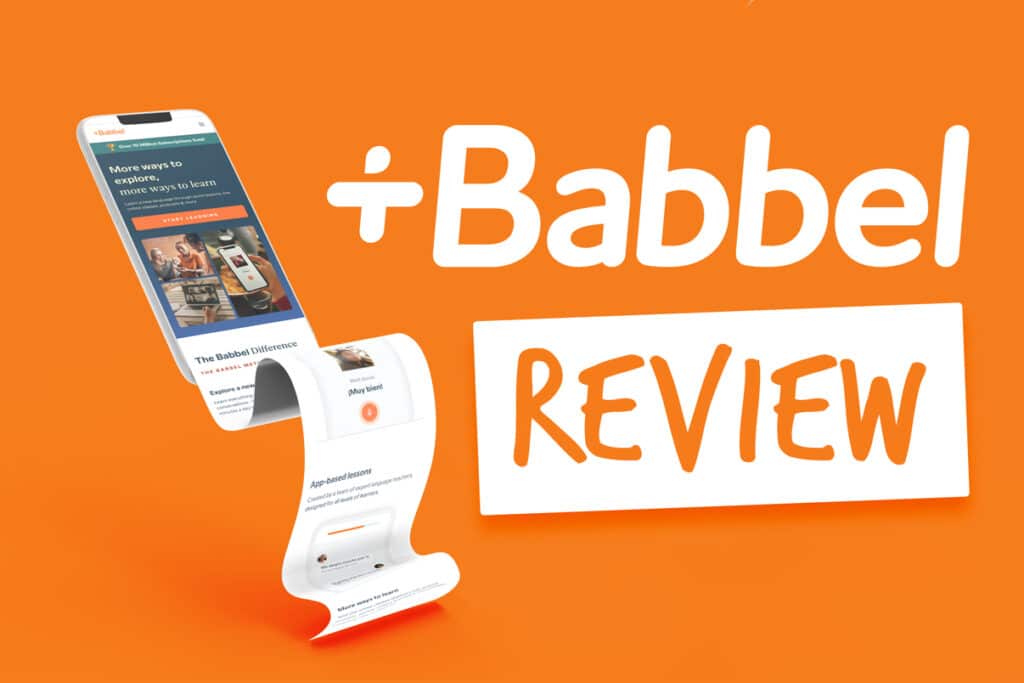
Babbel Review: Solid Foundation for New Language Learners [Updated for 2024]
Babbel is a popular language-learning app that’s recently gone through a rebranding process to better serve learners. I wanted to see for myself the unique workings that apparently make the program stand out from its competitors.
For this review, I chose German, a language in which I’ve had school-based instruction. I did this to see if it was suitable for intermediate and advanced learners, since not every language gets equal treatment in the amount of content available.
Overview
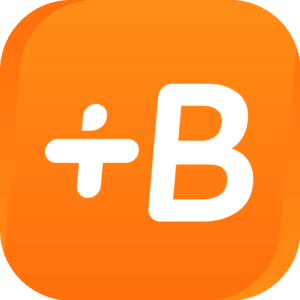
Name: Babbel
Description: The "world's first language learning app," based around 10-15 minute interactive lessons
Languages offered: 14
Offer price: Monthly subscription from $9.60/month up to a one-time fee of $190.99 for lifetime access
Summary
Babbel is a great app for anyone just starting a new language, with content that can provide a solid foundation for later learning. However, the app is limited in scope, with inconsistent amounts of content across languages.
- User friendliness - 9/109/10
- Delivers on promises - 8/108/10
- Authenticity - 8/108/10
- Value for price - 6/106/10
Pros
- Teaches applicable, useful conversational language
- Lessons build upon previous knowledge
- Includes language tips within lessons about grammar, formality, sentence structure, etc.
Cons
- Limited language choice, considering the age of the app
- Amount of content and features offered are inconsistent across languages
- Not all languages offer intermediate or advanced levels
- Not enough variety in exercise format
Contents
- Babbel Review: A Brief Overview
- What Languages Can You Learn with Babbel?
- How Does It Work?
- What Are Babbel’s Main Features?
- How Much Does Babbel Cost?
- What Are the Pros of Babbel?
- What Are the Cons of Babbel?
- How Does Babbel Compare to Other Language Apps?
- The Final Verdict
Download: This blog post is available as a convenient and portable PDF that you can take anywhere. Click here to get a copy. (Download)
Babbel Review: A Brief Overview
First launched in 2007, Babbel bears the title of being the world’s first language-learning app. With lessons developed by a team of experienced linguists, Babbel focuses on practical language and vocabulary you’d use in real-life situations.
I used Babbel for a week and overall found it to be quite a nifty learning resource. At the end of my trial run, I can safely say that a beginner learner would likely learn a lot of foundational material from using only Babbel.
Similar to many other users of Babbel, I appreciated the lesson format and content, but the learning experience was a bit dry and in need of some vigor.
The reviewer in the video below gives a pretty good description of what you can expect from the Babbel program.
What Languages Can You Learn with Babbel?
Currently, Babbel has lessons available in 14 languages: Spanish, French, German, Italian, Russian, Portuguese, Turkish, Dutch, Swedish, Norwegian, Danish, Indonesian, Polish and English.
Their English course is available with instruction in French, German, Italian, Polish, Portuguese, Spanish, Swedish or Ukrainian. Other languages are also available with instruction in languages other than English. For example, you can learn Spanish with the course instruction in German.
How Does It Work?
Once you make an account with Babbel and pick your language of choice, you get to start your lessons.
You can answer some questions if you’re unsure of your level, but they’re self-assessments that ask for your confidence in certain language topics.
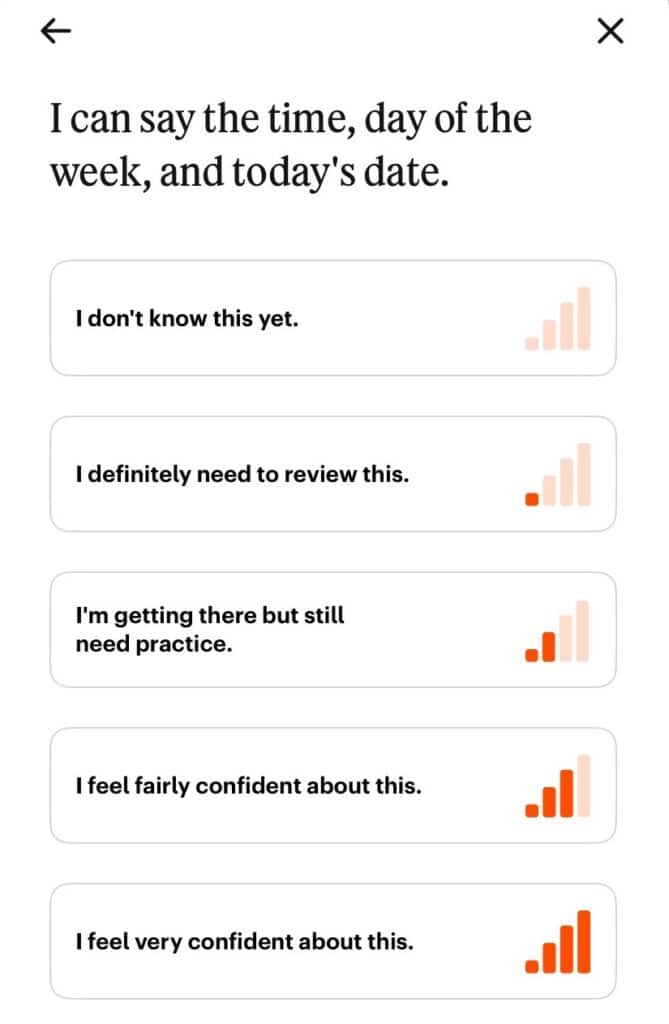
Based on the Common European Framework of Reference standards, Babbel claims to offer lessons that range from A1 (beginner) to C1 (proficient) levels, but this depends on the language.
In the German version, the lessons are split into newcomer (A1), beginner (A2), intermediate (B1) and upper intermediate (B2) levels. There are also topical courses on German dialects, idioms, business German and more.

The curriculum isn’t “locked” so you can skip around different lessons and courses as you wish. This differs from some other language learning apps that won’t let you proceed until you complete your current lesson or topic.
Each lesson will focus on a certain concept or vocabulary, which you’ll learn via exercises. The lessons mainly focus on different day-to-day situations such as dining and describing future actions.
What Are Babbel’s Main Features?
Babbel has a mix of core features such as speech recognition, progress checks and a review section. There’s also bonus content like live classes, Babbel Magazine and podcasts. Read on to dive into these in detail.
Babbel Lessons
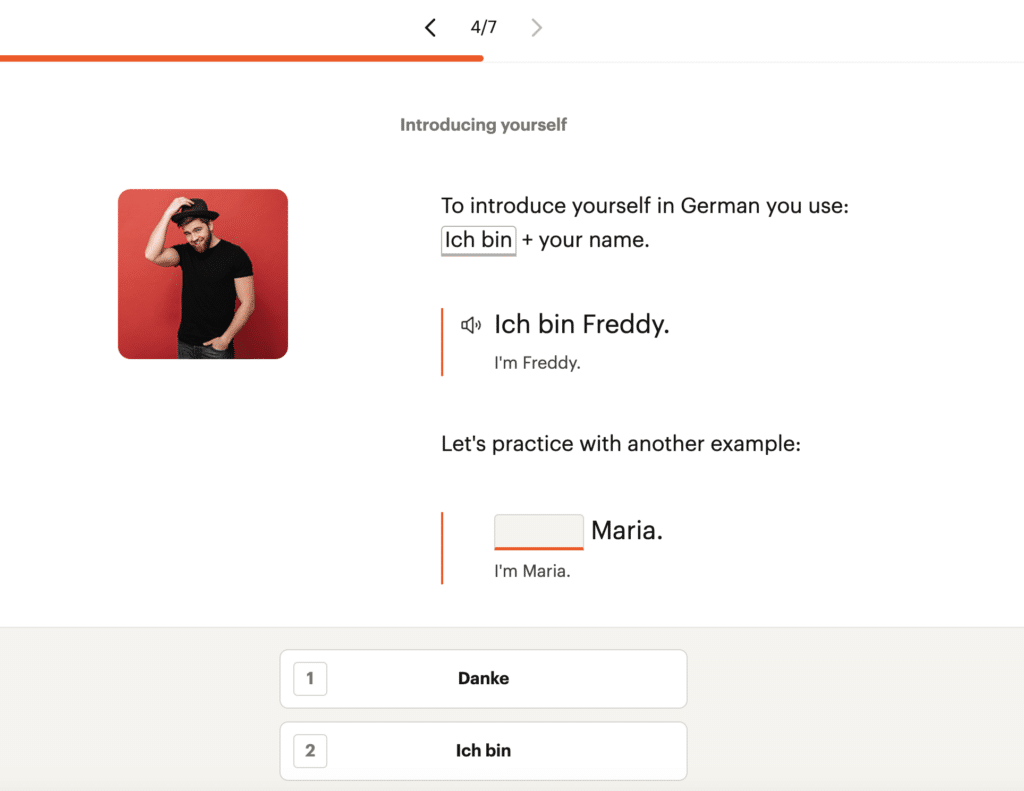
Babbel’s lessons are roughly 10 to 15 minutes long. Each lesson features both text and audio of the vocabulary, along with corresponding images. There are fill-in-the-blank and multiple-choice questions where you’ll have to provide translations.
There are also exercises where you’ll listen to and repeat phrases using the app’s speech recognition system. You can easily check your progress and set weekly learning goals with regular reminders to keep you on track.
There’s also a separate review section that lets you revisit what you’ve learned through writing, speaking, listening or flashcards. The review system utilizes spaced repetition, an effective learning tool based on timed intervals.
Alternatively, you can get some vocabulary practice in with some cute mini-games!
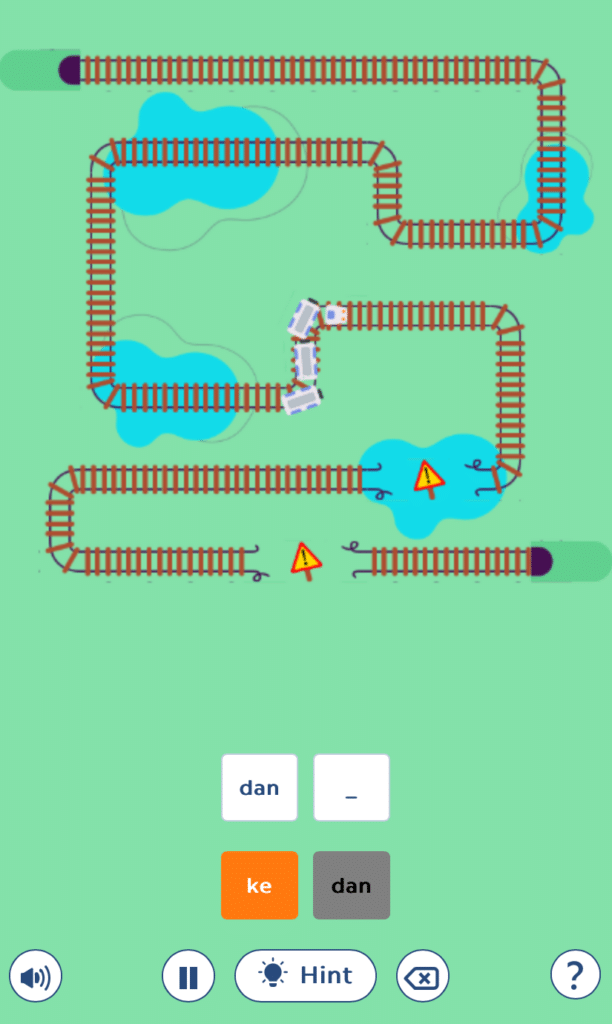
Everyday Conversations
With this feature, you can listen to conversations between two people with or without English subtitles. Then you step in to replace one of the speakers, using the speech recognition tool to say your part of the dialogue.
These conversations cover everyday situations such as chatting with someone at a bar, paying at a store and introducing a new colleague. Unfortunately, this feature isn’t available for every language, but it’s an extremely useful practice tool when it is.
Audio Recap
This feature is great for practicing your listening skills and reviewing the material you’ve learned in Babbel’s lessons in a real-world context. These guided audio lessons are around 10 to 14 minutes long and each corresponds to a certain course and lesson.
First, you’ll hear a dialogue broken down into smaller parts, along with some vocabulary and cultural explanations. Then, you’ll hear the whole dialogue again without interruption. Finally, you’ll take a quiz to test what you’ve learned.
Grammar Guide
This feature includes simple grammar explanations on topics such as personal pronouns, irregular verbs and adjectives. These are very short and include plenty of examples to support your understanding.
For German, there are currently only 11 grammar topics with the promise that more are coming soon. For some languages like Dutch and French, this feature isn’t currently offered.
Babbel’s Bonus Content
Besides its main learning program, Babbel offers a few extra resources for those who want to further their learning.
Live Classes

Babbel Live is a service that lets you take live classes with language instructors. After paying for a plan, you sign up for the class that suits your needs and schedule. You then join the class at the assigned time and get personalized instruction from your teacher.
Podcasts and Magazine
Besides these classes, Babbel also offers language podcasts and a magazine that features helpful articles for learners. The podcasts are available on the app, but you can also find them on Apple Podcasts and Spotify.
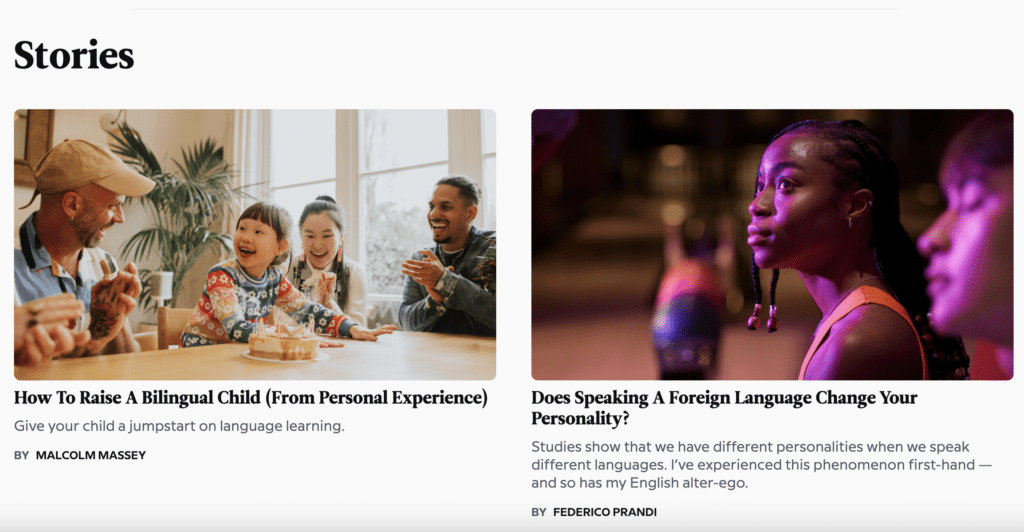
Culture Bites
Some of the languages in Babbel offer an interesting section on “Culture Bites,” which consists of short videos about cultural facts and insights. For example, depending on the language, you might find out more about popular food, holidays and major figures such as writers and artists.
These are mostly in English, but they’re fun to watch, and they deepen your appreciation of the language. You can even use what you’ve learned as conversation topics with native speakers!
How Much Does Babbel Cost?
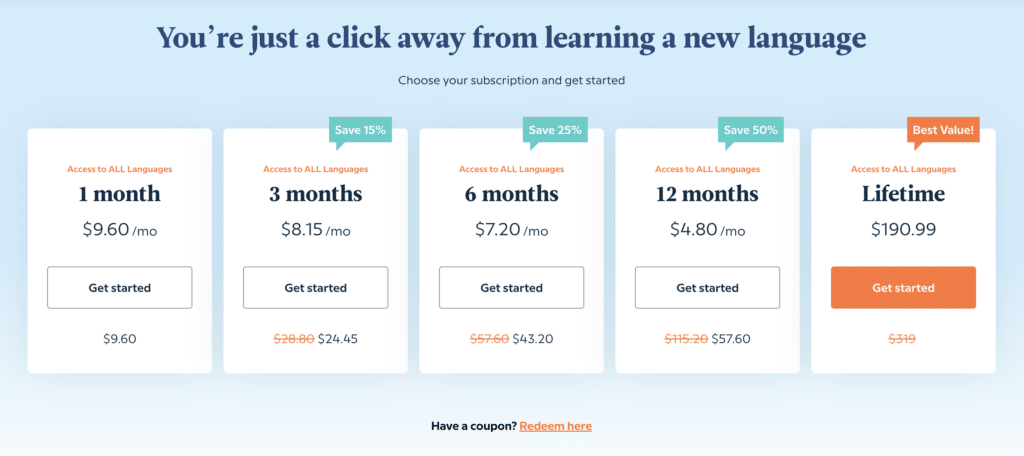
Babbel doesn’t offer a free trial. However, registration and the first lesson of any course are free. After that, you’ll be expected to sign up for a paid plan.
Babbel offers a variety of subscription options. Currently, the monthly subscription is $9.60/month. If you’re willing to commit to a longer subscription, the monthly cost goes down. For example, if you choose the 12-month option, currently you’ll pay $57.60 which breaks down to $4.80/month.
Note that these prices are offered on the website, while prices are higher if you subscribe within the app. All Babbel subscriptions give you access to all the languages they offer.
Here’s how Babbel’s prices compare to other language learning programs (prices subject to change):
- Memrise PRO: $27.99/month, $130.99/year or $249.99 lifetime
- Super Duolingo: $12.99/month or $83.99/year
- Busuu Premium: $13.90/month, $50.70 for 6 months or $83.40/year
What Are the Pros of Babbel?
Teaches applicable, usable language
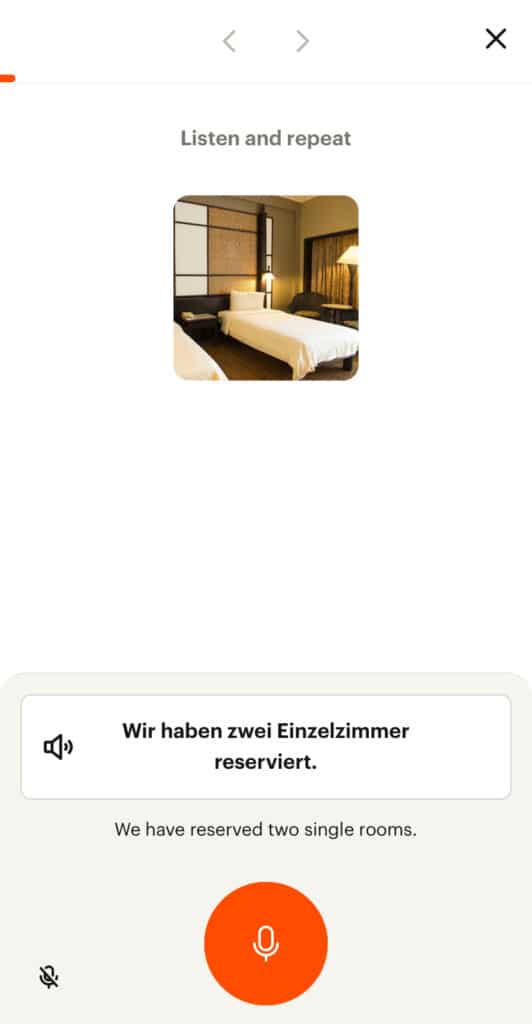
Babbel’s exercises let you encounter language without overwhelming frills. The vocabulary is used in a realistic manner, so what you learn can be used pretty quickly in real-life scenarios.
This is best expressed in the dialogues presented in the Audio Recap and Everyday Conversations features. These dialogues feature material you’ve learned in a normal, casual context. It was during these exercises that I was the most engaged and alert as I was seeing (and using) the material in action.
This is a great advantage that Babbel has, as many existing language learning apps tend to focus on isolated vocabulary as opposed to usable phrases. This strength could be further amplified if a bit more cultural context was included and the features were offered for every language.
Lessons build upon previous knowledge
Babbel’s curriculum is designed to have a logical flow of progression. You start with very basic words and phrases before moving on to more involved conversation and sentences.
From learning how to introduce yourself to describing activities, Babbel makes sure that you’re climbing a structurally sound ladder of language. I never felt that I was getting hit with curveball questions or that the vocabulary was level-inappropriate.
And you’re not going to forget the material you learned in earlier lessons, either. You’re guaranteed to encounter previous words and phrases again while balancing the new content of your current lesson.
This kind of format made my learning experience both comfortable and stable. Even as I progressed to the next level, the lessons were still inlaid with familiar territory regardless of the new concepts or vocabulary.
Includes language tips within lessons
One of my favorite features is the inclusion of tips related to what you’re learning. These talk about grammar, formality, sentence order and so on.
As simple and brief as these tips are, they’re great additions that can build your authentic usage of a language. I’d even say they’re critical to helping build confidence in language learners, but unfortunately, they’re not as common in other language learning apps.
What Are the Cons of Babbel?
Limited language choice
At the moment, Babbel only offers 14 languages, and most of these are European. This low number may decrease the number of users who would want to use Babbel.
While 14 is a fairly standard number of languages, I point this out specifically because of Babbel’s lifespan on the app market. After all these years, I’d expect that Babbel would have a more varied and extensive list of languages offered.
Of course, this may be due to a number of limiting factors. A great deal of time and effort was likely spent on each of the language courses. However, I hope that Babbel is working to bump up their roster so that they can reach a great deal more learners.
Amount of content is inconsistent across languages
Depending on the language you’re learning, you may find that Babbel doesn’t provide advanced or even intermediate-level courses. For example, Babbel’s German course goes up to the upper intermediate level while its Russian course ends at the beginner level.
This means that once you finish all the courses offered, you may have to find another learning resource to reach the advanced level. This affects the value of the program considering its cost. For some languages, it may be worth it, while for others you may want to invest in a more comprehensive program.
In addition, some of the languages offer fewer features than others. For example, some languages lack the Culture Bites feature or the Grammar Guide. This imbalance means that the learning experience is very different depending on which language you’re learning.
Exercises can be somewhat dry
Unlike a few other popular language learning apps, Babbel isn’t very game-like in format. I did wish that the exercises were a tad more engaging. While thorough, Babbel’s lessons and exercises can become rather rote over time.
This is primarily because the overall exercise format isn’t varied in style. The questions don’t change much and the answers are often the same inputs. Personally, I got a bit tired of the repetitive nature of my studies, though I recognize that they can quicken vocabulary memorization.
Babbel might benefit from a bit more excitement and variety in their lessons. It would be nice to see more multimedia features incorporated such as videos to make the lessons more interactive.
How Does Babbel Compare to Other Language Apps?
Duolingo
The biggest distinction between Babbel and Duolingo is Duolingo’s lack of a price tag for the basic version. This is a huge selling point that Babbel currently can’t compete against, especially for the money-wise learner.
Duolingo also seems to have more lesson units with game-like exercises. They’re organized in a tree that becomes more accessible the more units you complete.
However, quantity doesn’t always mean quality, and Babbel’s lessons appear more topically comprehensive than Duolingo’s. Babbel makes it a point to focus on authentic context, whereas Duolingo seems more intent on making you memorize words and phrases in isolation.
Additionally, Babbel’s content is more realistic. Duolingo has a habit of using strange but amusing sentences to help you learn vocabulary, though they’re not especially helpful for real-life usage. Babbel, on the other hand, goes out of its way to provide dialogue exercises and usage tips that focus on how to speak more naturally.
See our in-depth review of Duolingo.
FluentU
FluentU differs greatly from Babbel in that it’s video-based and provides an immersive language learning experience without structured courses.
With FluentU, you hear languages in real-world contexts—the way that native speakers actually use them. Just a quick look will give you an idea of the variety of FluentU videos on offer:

FluentU really takes the grunt work out of learning languages, leaving you with nothing but engaging, effective and efficient learning. It’s already hand-picked the best videos for you and organized them by level and topic. All you have to do is choose any video that strikes your fancy to get started!
Each word in the interactive captions comes with a definition, audio, image, example sentences and more.
Access a complete interactive transcript of every video under the Dialogue tab, and easily review words and phrases from the video under Vocab.
You can use FluentU’s unique adaptive quizzes to learn the vocabulary and phrases from the video through fun questions and exercises. Just swipe left or right to see more examples of the word you're studying.

The program even keeps track of what you’re learning and tells you exactly when it’s time for review, giving you a 100% personalized experience.
Start using the FluentU website on your computer or tablet or, better yet, download the FluentU app from the iTunes or Google Play store. Click here to take advantage of our current sale! (Expires at the end of this month.)
Rosetta Stone

Rosetta Stone is another major player in the language learning field. With its decades of prestige, it may already be perceived to be better than Babbel in all aspects. But that’s not truly the case.
Rosetta Stone uses a more “hands-off” teaching approach, letting you learn your target language without much instruction. You primarily learn with picture-based exercises, unlike Babbel’s mostly text-based ones.
This can make Rosetta Stone suitable for learners who prefer a more “intuitive” study method. In terms of the subscription price, Babbel is cheaper than Rosetta Stone.
Unlike Babbel, Rosetta Stone barely discusses grammar or context. This might be nice for learners who don’t enjoy studying such technical aspects, but it’s frankly a downside that can work against true language prowess.
Drops

Let’s compare Babbel with a more recent, yet quite popular, addition to the language learning scene: Drops.
Offered in over 45 languages, Drops is a free minimalist-style app that provides daily 5-minute language lessons split into categories. So while Babbel’s lessons aren’t exactly lengthy, they can feel long compared to Drops’.
Babbel’s exercises are quite text-heavy, while Drops’ exercises appeal more to visual learners since they involve associating pictures with vocabulary.
Drops focuses on isolated words and vocabulary (plus their pronunciations) but doesn’t discuss grammar at all. It doesn’t really provide instruction on anything besides words and letters, to the point that the app feels bare-bones at times. Again, Babbel wins by providing more technical details of the language.
See our full review of Drops to understand more about what the app offers.
Busuu

Babbel is often confused with Busuu since both apps have relatively similar priorities. They both aim to teach you applicable sentences, phrases and grammar in your target language.
The free version of Busuu gives you access to some of the starter lessons in one language. With the paid plan, you get access to community-based features, grammar lessons and review functions.
Busuu’s exercises aren’t too different from Babbel’s, though they’re organized in a set linear fashion. This means, unlike in Babbel, you can’t skip around Busuu’s lessons. Both of their lessons are supplemented with helpful tips and dialogue-based exercises.
Busuu also places a stronger emphasis on its community-based features, in which you can interact with other learners or native speakers. Babbel doesn’t seem to have much of its own community, besides its Babbel Live feature that lets you learn from native speakers.
See our review of Busuu, as well as our in-depth comparison between Babbel and Busuu.
The Final Verdict
Ultimately, Babbel is a great app for those just starting a new language. Its content can very likely provide a stable foundation of basic vocabulary and phrases for beginner learners, who can then seek more advanced and comprehensive language instruction.
Unfortunately, Babbel seems limited in its scope of content and its lesson plans for many of the languages it offers. I find this to be its biggest weak point which can make users vulnerable to a less fulfilling learning experience than expected.
With more content and depth, Babbel could greatly enhance its already strong educational potential. Due to its popularity, I’m certain that more revamps and updates are coming for Babbel, and I’m eager to see how it evolves to live up to the hype.
Check out all of our top language app recommendations here:





